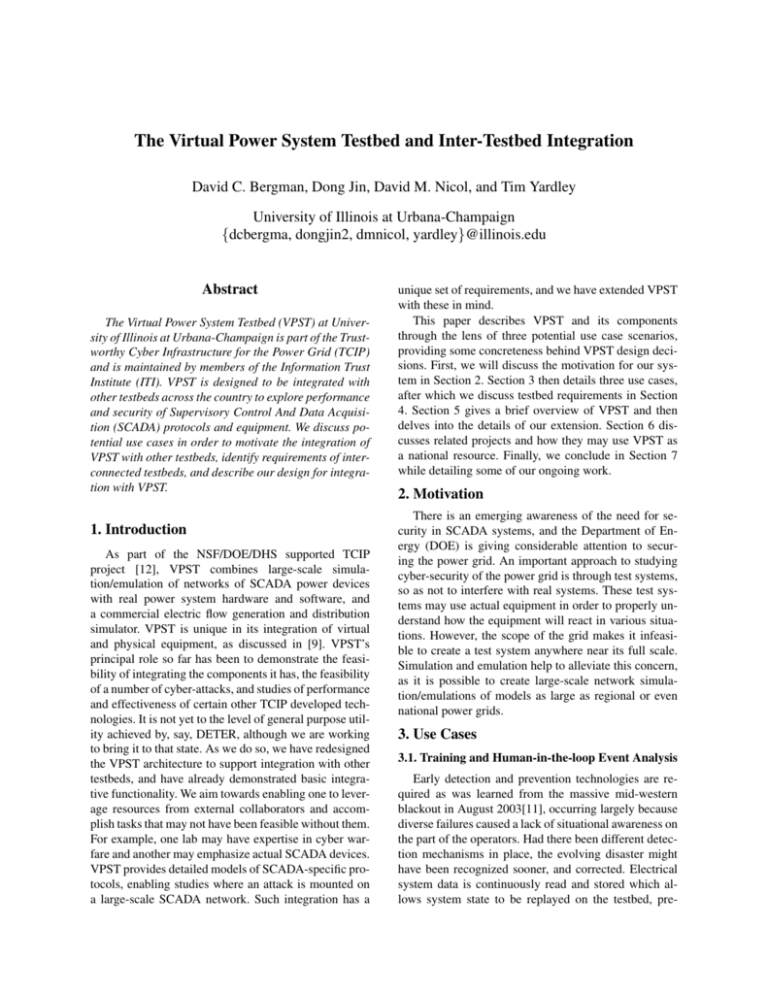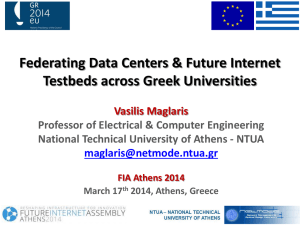The Virtual Power System Testbed and Inter-Testbed
advertisement

The Virtual Power System Testbed and Inter-Testbed Integration
David C. Bergman, Dong Jin, David M. Nicol, and Tim Yardley
University of Illinois at Urbana-Champaign
{dcbergma, dongjin2, dmnicol, yardley}@illinois.edu
Abstract
The Virtual Power System Testbed (VPST) at University of Illinois at Urbana-Champaign is part of the Trustworthy Cyber Infrastructure for the Power Grid (TCIP)
and is maintained by members of the Information Trust
Institute (ITI). VPST is designed to be integrated with
other testbeds across the country to explore performance
and security of Supervisory Control And Data Acquisition (SCADA) protocols and equipment. We discuss potential use cases in order to motivate the integration of
VPST with other testbeds, identify requirements of interconnected testbeds, and describe our design for integration with VPST.
1. Introduction
As part of the NSF/DOE/DHS supported TCIP
project [12], VPST combines large-scale simulation/emulation of networks of SCADA power devices
with real power system hardware and software, and
a commercial electric flow generation and distribution
simulator. VPST is unique in its integration of virtual
and physical equipment, as discussed in [9]. VPST’s
principal role so far has been to demonstrate the feasibility of integrating the components it has, the feasibility
of a number of cyber-attacks, and studies of performance
and effectiveness of certain other TCIP developed technologies. It is not yet to the level of general purpose utility achieved by, say, DETER, although we are working
to bring it to that state. As we do so, we have redesigned
the VPST architecture to support integration with other
testbeds, and have already demonstrated basic integrative functionality. We aim towards enabling one to leverage resources from external collaborators and accomplish tasks that may not have been feasible without them.
For example, one lab may have expertise in cyber warfare and another may emphasize actual SCADA devices.
VPST provides detailed models of SCADA-specific protocols, enabling studies where an attack is mounted on
a large-scale SCADA network. Such integration has a
unique set of requirements, and we have extended VPST
with these in mind.
This paper describes VPST and its components
through the lens of three potential use case scenarios,
providing some concreteness behind VPST design decisions. First, we will discuss the motivation for our system in Section 2. Section 3 then details three use cases,
after which we discuss testbed requirements in Section
4. Section 5 gives a brief overview of VPST and then
delves into the details of our extension. Section 6 discusses related projects and how they may use VPST as
a national resource. Finally, we conclude in Section 7
while detailing some of our ongoing work.
2. Motivation
There is an emerging awareness of the need for security in SCADA systems, and the Department of Energy (DOE) is giving considerable attention to securing the power grid. An important approach to studying
cyber-security of the power grid is through test systems,
so as not to interfere with real systems. These test systems may use actual equipment in order to properly understand how the equipment will react in various situations. However, the scope of the grid makes it infeasible to create a test system anywhere near its full scale.
Simulation and emulation help to alleviate this concern,
as it is possible to create large-scale network simulation/emulations of models as large as regional or even
national power grids.
3. Use Cases
3.1. Training and Human-in-the-loop Event Analysis
Early detection and prevention technologies are required as was learned from the massive mid-western
blackout in August 2003[11], occurring largely because
diverse failures caused a lack of situational awareness on
the part of the operators. Had there been different detection mechanisms in place, the evolving disaster might
have been recognized sooner, and corrected. Electrical
system data is continuously read and stored which allows system state to be replayed on the testbed, pre-
senting operators with the same data as existed at the
time of the blackout (or some other notable event). However, the testbed can provide real or simulated versions
of new technology. This allows operators to react to
what they now see (owing to the simulation), which
may be different from the original incident. As different control decisions are made (e.g. open a breaker ) the
testbed shifts from playing back observed state information from the original event to generating a new state
trajectory, based on the new control decisions. By integrating with real device/emulation testbeds, VPST has
two significant benefits over a traditional power system
training simulator: (1) actual hardware is in the loop, (2)
the communications system is modeled, allowing a more
faithful interaction.
This use case requires the testbed to ensure the following: secure connectivity for protecting sensitive information such as strategic decisions; reproducibility
for event replay and analysis; scalability for large-scale
power grid experiments; and flexibility and fidelity for
easy construction of realistic scenarios from the operators’ point of view.
3.2. Analysis of Incremental Deployment
Securing the power grid requires an overhaul of the
existing infrastructure. However, the size and scope of
the grid necessitates that the change be gradual, not
instantaneous. When old and new technologies coexist, there is the possibility that unforeseen interactions
may occur. For instance, current communications make
heavy use of the DNP3 protocol[5], yet this protocol
provides little in the way of security. Effort has been
put into creating an extension to DNP3—DNP3 Secure
Authentication (DNP3SA)[1] that addresses authentication concerns with DNP3. As this is deployed, the legacy
support must be maintained. DNP3SA is just one example of many. We may also want to analyze strategies for incremental deployment of new technologies,
tested against a multitude of network conditions (e.g.
lossy networks, congested networks, insecure environments, while under attack, or with the inclusion of corrupted data packets) and collect related statistics (e.g.
bandwidth usage, latency, dropped packets, success ratio for communications, overhead incurred, etc.).
When testing a new protocol, device, or policy, there
are a few important requirements: reproducibility to ensure that any changes are a direct result of the new technology in question; high performance in that we must
accurately model the scale of the real power grid; customizable in order to provide a quick turnover from one
configuration to another; and high fidelity in order to
guarantee that a new technology behaves the same in
simulation as in the wild.
3.3. Attack Robustness Analysis
A third use case is analyzing the robustness of a design against an attack. For instance, the DETER testbed
has a highly provisioned communications network that
is often used to test new protocols against well-defined
attack models. Also, Idaho National Labs (INL) has
SCADA equipment for use in experiments. However,
there is currently no safe way to launch an attack on a
large-scale SCADA network – VPST provides such an
avenue for testing the reliability of a SCADA network in
the face of an attack. We can leverage the cyber-attack
capability of DETER, while integrating the real power
equipment that INL operates. VPST provides the crucial
third testbed that can simulate the SCADA network at
full-scale with the added benefit of causing no harm to
the actual power grid.
The main requirements for such an experiment are:
secure connectivity to guarantee that attacks are contained to the network under duress; reproducibility to
allow repeated attacks against various defenses; and fidelity to ensure the system under attack behaves reliably.
Additionally, this use case actualizes an attack, so it requires the ability to abstract attacks in order to prevent
WAN links from saturating (e.g., during a ping flood).
4. Inter-Testbed Connection Requirements
4.1. Secure Connectivity
Since the integrated testbed is targeted for SCADA
network security analysis, security of the testbed itself is an absolute requirement. The testbed may face
threats from external cyber-attacks as well as internal
malicious code, which could intentionally or accidentally gain unauthorized access to secret assets. A good
security policy should enable several layers of protection including transmission security, authentication and
access control, traffic isolation, intrusion detection, logging and reporting. However, existing security technologies are generally not implemented in real SCADA systems because real SCADA devices usually have limited
processing capabilities, operate in real time, and are typically not designed with cyber-security in mind.
To ensure a secure cross-testbed experimental environment, access control policies and strong authentication should be enabled at all access points; the access
model should deny access to any party not explicitly allowed; and only ports and services required for operations should be allowed. Open PCS Security Architecture for Interoperable Design(OPSAID)[10] is a framework for accelerating development and adoption of a
wide range of security functionality in control systems
using IP networks. Its technical approach is to use existing open-source technologies whenever possible. This
approach could be augmented with additional layers of
protection to cover the full scope of secure connectivity.
We have analyzed the current testbed situation and
have implemented various measures to ensure the secure connectivity required by VPST. First, we have segregated the virtual nodes onto a private network. This
prohibits incidental traffic emanating from our network
and interfering with the outside world unless specifically redirected to do so. Also, communication between
all components utilizes proven secure protocols. The
local systems all communicate using OpenVPN (using
SSL for encryption). The remote testbeds connect using
IPSec, which provides basic security guarantees.
4.2. Performance
For a testbed to be useful, it must provide timely results. In order for this to occur, certain characteristics
must hold true for both the inter-testbed connections
(ITC) as well as the performance of a single testbed.
When connecting two or more testbeds, precautions
must be taken in order to provide guarantees about performance, primarily concerning the latency of information transfer between testbeds. To allow for efficient
scaling, our ITCs handle multiple connections by having a single point of contact and then distributing the
workload to other components. Instead of having an individual connection for each emulated host, we aggregate the data and use a tagging mechanism to differentiate between the hosts using “super nodes” as discussed
in Section 5.3.2.
Connecting with a simulated environment has its own
set of issues, namely the interaction between emulation
and simulation. The communication simulator in VPST
has the capability to absorb latency caused by emulated
packets. Since emulated packets take precedence over
simulated packets, real communication will always remain as close to real-time as possible. Look-ahead is the
ability to predict the amount of simulated time that could
be safely advanced in one process without causing errors
in other concurrent processes. Where possible, VPST-C
utilizes look-ahead algorithms in order to keep the simulation running as smoothly as possible.
The other source of latency is in the simulation control plane. The main source of information provided over
this link ought to be known ahead of time and therefore
can be transmitted prior to the start of simulation. By
shifting the bulk of control messages outside the simulation itself, we can minimize the overhead incurred by
control messages.
Another performance concern is that of scalability.
One of VPST’s contributions to the SCADA testbed
community is that we provide a highly scalable network simulator. Therefore, we must ensure that the scale
of networks we can simulate is sufficient to justify the
interconnection of other testbeds with VPST. VPST is
capable of simulating over a million devices and the
electrical simulation can handle more than one hundred
thousand buses[3]. The size of a power grid that can be
simulated with this much capacity may be appreciated
by comparison: a city the size of Madison, WI (about a
quarter of a million people) has a grid with a couple hundred buses. In order to simulate a network of this scope
in real-time, we make use of the the Trusted ILLIAC[6]
as discussed in Section 5.2.
4.3. Resource Allocation
Flexible configuration has been addressed for standalone simulation/emulation testbeds in [4] and [7]. Further, an integrated testbed requires an accurate resource
mapping among testbeds for balancing customizability and speed. VPST takes the decentralized approach,
where interfaces to other testbeds are decomposed into
modules for the ease of customization. Details are discussed in Section 5.3.
VPST intelligently partitions simulation models for
balancing resources and minimizing communication
overhead across multiple machines. Similarly, a good
mapping may minimize the number of links across heterogeneous testbeds, though it is often hard to determine if a mapping is overloaded at the initial stage of an
experiment, especially when human decisions are later
involved. Therefore, techniques for overloaded link detection and dynamic resource mapping optimization are
desired. Successive mappings are adjusted based on the
feedback from the detection system and the prior mapping, until no overload is detected, or until all physical
resources are depleted.
4.4. Reproducibility
The dynamics of the real SCADA network cover a
wide range of conditions including, but not limited to
the size of the network, type of underlying physical
medium, available bandwidth and time-varying traffic
patterns. Therefore, precisely repeating the experimental conditions and reproducing entire or partial results is
a property of a good testbed. Integrating with a simulation testbed enhances reproducibility, since the entire
parameter space including both input and environment
configuration can be fully controlled.
Reproducibility in the scope of inter-connected
testbeds requires conducting experiments in a controlled
and interactive manner, especially allowing human-inthe-loop decision, as discussed in Section 3.1. Experimenters are given the opportunity to tune certain model
parameters online, such as link connectivity and event
response mechanisms. VPST then progresses along a
new experimental trajectory, which is recorded as tcpdump/libpcap traces for analysis and later reproduction.
Lastly, the testbed must be able to handle the un-
predictability of long-distance communication. For instance, if VSPT receives traffic with remote origination,
the simulation must be identical from one run to the next,
regardless of inter-site latency. VSPT utilizes algorithms
that deal with this on a local level, but it also must be addressed in the context of inter-operating testbeds.
4.5. Fidelity
To provide high fidelity, VPST-C must be as transparent as possible. That is, real-world equipment should
not be able to tell that it is communicating with a virtual
host. In order to present this appearance to a real control station, for instance, issues such as latency, realistic
data patterns, and accurate virtual hosts are all important
aspects of VPST. Latency has been discussed in Section
4.2, but realistic data and accurate hosts both fall under
the auspice of fidelity requirements.
Realistic data patterns are created through the interactions of each of the layers modeled in VPST-C. Virtual
hosts are responsible for creation of such data. These virtual hosts can be as abstract as a “router” with a simple
MAC layer or as detailed as an “SEL 421 Relay” with
a complete DNP3/MODBUS stack and high resolution
Ethernet.
Fidelity is often a counterpoint to performance in that
the more accurately a host is modeled, the more computation is required. As such, the trade-off needs to be
considered individually for each project that requires interaction with VPST.
ITC: In order to connect with a remote testbed, we extend the basic VPST architecture by use of ITCs, discussed further in 5.3. Figures 1 and 2 both show one
remote testbed, but this can be scaled to handle more
than one remote connection. The ITC is responsible for
ensuring that two testbeds are able to efficiently and expressively communicate with each other as to facilitate
their interaction.
Trusted ILLIAC: Another enhancement to the VPST
architecture we have introduced is the use of high
performance computing clusters, such as the Trusted
ILLIAC[6] and its 512 cores, to scale even further. VPST
supports model partitioning to intelligently spread virtual nodes across the allocated processors so as to minimize inter-processor communication. This allows an
almost-linear scaling of performance per core. The Local Controller is responsible for interpreting configuration files in order to partition the graph and allocate the
Trusted ILLIAC resources.
Trace Files: We have also modified VPST to work with
trace files. VPST now has the capability of dumping the
traffic into a tcpdump file that can be replayed at a later
time. First, this allows an external entity (e.g. a power
company) to use our testbed to examine their network
traces for whatever purpose they may have (e.g. testing a prevention policy). Secondly, this allows replaying
experiments in order to examine how real-world equipment interacts under different configurations.
5. VPST Architecture
Figure 1. VPST System Diagram
5.1. Base System Overview
converter
As discussed in [9], VPST is divided into three main
subsystems, as seen in Figure 1:
VPST-E handles electrical simulation. The primary
component here is PowerWorld which is capable of simulating large scale electrical networks at the bus level.
We use this to model city-sized or larger power grids.
VPST-C handles network simulation based on
RINSE[7], which provides a highly scalable virtual network that is used to model the cyber domain of
the electrical grid.
VPST-R-local represents all the real devices. Any software that is run rather than simulated resides on some
real device in the VPST-R-local, and is represented inside of VPST-C by a device proxy. Devices in VPST-Rlocal are capable of interacting with VPST-E through a
converter, and VPST-C through its emulation capability.
5.2. Enhanced VPST
As seen in Figure 1, VPST-R-remote represents a remote test bed communicating with VPST through an
ITC installed at the remote site. We have enhanced
VPST with the following significant augmentations:
VPST-E
converter
ITC - Inter-Testbed Connector
VPST-R
Local
Emulation
VPST-C
ITC
ITC
VPST-R
Remote
5.3. Inter-Testbed Connector Framework
Figure 2 shows the ITC architecture. The control
plane and the data plane are separated because the control channel is often more sensitive to latency and also
requires less bandwidth than the data channel. In addition, control signals likely require higher security level
than traffic data does. When two testbeds are initially
connecting to each other, the ITC in VPST-C is always identified as the master controller, which is responsible for making a high-level resource allocation plan
based on the requests initiated from slave ITCs in other
testbeds. Only the local ITC is allowed to communicate
with the local controller so as not to violate the local
security policy. The architecture design is decomposed
into individual modules to allow customization and facilitate the extension of functionality.
5.3.1. Simulation Control Plane
ITC Controller, the hub of an ITC, exchanges control
commands with a remote ITC and collects/distributes
these control commands with the local control plane. Secure connectivity is ensured here through access control
policies and authentication mechanisms.
Resource Allocator is responsible for managing resource allocation based on requests from remote
testbeds and responses from local resources. Load balancing should be optimized here to improve performance and fidelity. The Resource Allocator is also responsible for checking the correctness of the topology
mapping and detecting IP address conflicts across multiple testbeds. Since VPST-C is the central component of
the system and provides the interconnection, IP uniqueness should be guaranteed by VPST-C. IP conflicts in
the simulator are automatically resolved through its IP
reassignment procedure in the case of simulation, and
performs IP translation when real devices are used.
Resource Configurator is responsible for configuring
network components such as hosts, links and traffic. Using the Domain Modeling Language (DML) in VPST-C
makes the configuration process both flexible and reproducible. DML is a simple scripting language with a hierarchical attribute tree notation. Each node is syntactically nested with all its attributes and its child nodes to
ease configuration for large-scale network experiments
and, by accurately modeling the network stack, to support high-fidelity distributed experimentation.
Run-time Controller is responsible for controlling live
experiments. This could include tasks like starting a DoS
attack or altering the data polling pattern based on observed states at the remote site. However, overuse of
dynamic adjustment may increase communication overhead, lowering performance. Therefore, a good practice
may be to shift the majority of cross-testbed communication to initialization and cleanup stages.
Error Detector is responsible for detecting abnormalities that occur in a live experiment. These could include errors such as host failure, asynchronization, or
known warnings due to certain experimental parameters/intermediate outputs exceeding a preset threshold.
To ensure fidelity, the system will then take corresponding actions such as relocating extra hosts, generating local or cross-testbed alerts, writing events to local system logs, or terminating/restarting experiments. The error detector can either be triggered by an abnormal event
or perform periodic checks to ensure a healthy experimental environment.
Data Plane Configurator is responsible for issuing
controls to the data plane at the initialization, run-time
and cleanup stages of an experiment. Controls include
setting the distribution of incoming traffic, how to aggregate outgoing traffic, and specifying the types of reports
to collect upon completion of an experiment.
5.3.2. Model Data Plane
Traffic Distributor is responsible for bridging traffic
data across two testbeds based on the settings from the
data plane configurator. The number of cross-testbed
physical links are minimized for performance gain.
Therefore, traffic data is often aggregated and the traffic distributor is used to forward traffic to the right destination. VPST-C has one type of node called a “super node”, which handles real traffic from the emulation
channel. It appends a new virtual IP header based on an
IP translation table established at the initialization stage
by the resource allocator, and then distributes packets
as if the super node is a traffic generator. Upon leaving
VPST-C, the virtual IP header is extracted so that a remote real testbed can correctly handle the packet.
Measurement Reporter is responsible for collecting
statistics of the experiment ranging from a single value
like average packet loss rate to detailed per-host status
reports. Upon completion of an experiment, reports are
sent to the remote testbeds as instructed by the control
plane. This module is included in the data plane because
in some cases, remote experimenters may need the entire
trace files, which require large bandwidth. Meanwhile,
the security level of the data channel must be raised accordingly if the reports contain sensitive data.
6. Related Work
DETER[4] is an Emulab-based security testbed with
a shared infrastructure of several hundred experimental nodes. Many attacking/malware models and tools
for traffic/topology generation and analysis are available
through DETER. These resources must be leveraged in
order to faithfully test the security of SCADA networks.
DETER also supports remote access while providing assurance for isolation and containment of each experiment. However, everything in DETER is real, from the
operating system to the network stack, which makes
replicating a SCADA network infeasible.
National SCADA Test Bed Program (NSTB)[2] was
jointly established at INL and Sandia National Laboratory (SNL). NSTB consists of 61 miles of cables, 7 outstations, and more than 300 monitoring points across the
nation. Many equipment manufacturers and government
agencies conduct tests on NSTB for finding tangible solutions to growing threats to the power grid. However,
NSTB is not publicly available. Even if it were, it is
still insufficient to explore the impact of various security
technologies on a nation-wide power grid. In addition,
it lacks the flexibility to explore different architectures,
Figure 2. ITC Architecture Diagram
VPST-C
Network
Simulator
Local
controller
ITC
ITC
Resource
Allocator
Simulation
Control Plane
Resource
Configurator
ITC
controller
Run-time
Controller
Error
Detector
Simulator
VPST-R-Remote
Measurement
Reporter
Data Plane
Configurator
Simulaton
Control
Plane
secure
links
Local
Testbed
Model
Data
Plane
Traffic
distributor
Model Data Plane
since it is primarily a physical system.
References
Virtual Control System Environment Project
(VCSE) [8] in SNL was designed to incorporate their
existing tools, including simulated, emulated, and
physical components to assess security vulnerabilities
in SCADA systems. The main difference from VPST is
that its OPNET-based simulation framework does not
scale nearly as well as RINSE.
[1] Dnp3
specification,
secure
authentication,
supplement
to
volume
2.
http://www.dnp.org/Modules/Library/Document.aspx.
[2] National
scada
test
bed
program.
http://www.inl.gov/scada/publications/index.shtml.
[3] Powerworld simulator. http://www.powerworld.com/.
[4] T. Benzel, R. Braden, D. Kim, C. Neuman, A. Joseph,
K. Sklower, R. Ostrenga, and S. Schwab. Experience
with deter: a testbed for security research. pages 10 pp.–
388, 0-0 2006.
[5] DNP.org.
Dnp: Distributed network protocol.
http://www.dnp.org.
[6] W. Hwu, W. Sanders, R. Iyer, and K. Nahrstedt.
Trusted illiac: A configurable, application-aware,
high-performance platform for trustworthy computing.
http://www.iti.illinois.edu/sites/default/files/docs/crisnowbird-06-talk-final.pdf.
[7] M. Liljenstam, J. Liu, D. Nicol, Y. Yuan, G. Yan, and
C. Grier. Rinse: The real-time immersive network simulation environment for network security exercises. In
PADS ’05: Proceedings of the 19th Workshop on Principles of Advanced and Distributed Simulation, pages
119–128, Washington, DC, USA, 2005. IEEE Computer
Society.
[8] M. J. McDonald, G. N. Conrad, T. C. Service, and
R. H. Cassidy. Cyber effects analysis using vcse. Tech.
Rep. SAND2008-5954, Sandia National Laboratories,
September 2008.
[9] D. M. Nicol, C. M. Davis, and T. Overbye. A virtual
power system testbed for cyber-security decision support. Proceedings of the 2009 INFORMS Simulation Society Workshop on Simulation: At the Interface of Modeling and Anaylsis.
[10] OPSAID. Department of energy office of electric delivery and reliability’s national scada testbed program.
Initial Design and Testing Report.
[11] PNNL. Looking back at the august 2003 blackout.
http://eioc.pnl.gov/research/2003blackout.stm.
[12] UIUC. Trustworthy cyber infrastructure for the power
grid. http://tcip.iti.illinois.edu.
7. Conclusion and Future Work
In this paper, we have shown that there is potential in
connecting VPST with remote testbeds, in order to take
advantage of their unique offerings. We have also discussed many of the concerns regarding integrating multiple testbeds as well as the methods that we employ to
alleviate said concerns. One of the next steps we would
like to take is to develop a black-box implementation
of the current ITC. This box would be installed in a remote testbed and would be responsible for seamlessly
connecting a remote testbed to ours with as little manual
configuration as possible. In addition to this, we believe
there is benefit in extracting as much efficiency out of
the WAN transmissions as possible (e.g., compression
of data and intelligent use of control messages to reduce
the amount of traffic that must pass over the link). For
instance, a real flooding attack would not be tolerated
over a WAN link since this will likely be the bottleneck.
Acknowledgments
We thank Susan Hinrichs for many constructive suggestions. This work was supported in part by a grant from
the National Science Foundation (CNS-0524695).








